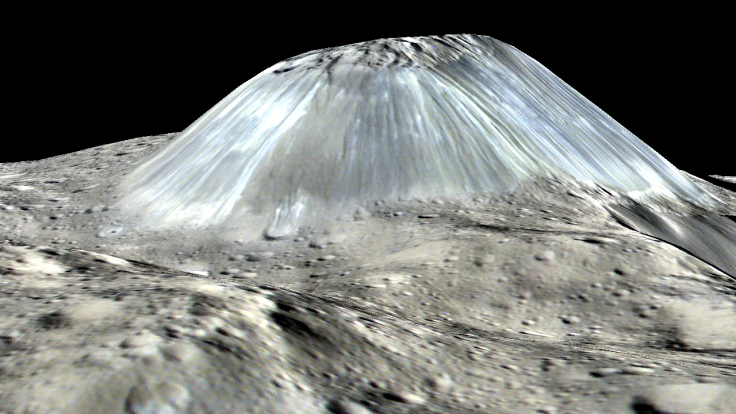Ceres’ Solitary Ice Volcano Ahuna Mons May Once Have Had Company

NASA’s Dawn spacecraft has been orbiting Ceres — a 600-mile-wide dwarf planet in the asteroid belt — since March 2015. Since then, it has become evident that the dwarf planet has a raft of intriguing geological features, such as a clump of bright spots located in Occator Crater, permanently shadowed regions that may still have deposits of water-ice, and Ahuna Mons — a cryovolcano that erupts molten and salty water-ice.
What makes the 2.5-mile-tall Ahuna Mons truly unique is the fact that for some inexplicable reason, it’s the only cryovolcano on Ceres — something that has long puzzled astronomers.
“Imagine if there was just one volcano on all of Earth. That would be puzzling,” Michael Sori from the University of Arizona in Tucson, the lead author of a new study accepted for publication in Geophysical Research Letters, said in a statement released Thursday.

According to the study, it is highly likely that millions or billions of years ago, there may have been several cryovolcanoes on Ceres. However, the authors of the study argue, these structures have since flattened out due to a process known as viscous relaxation.
Viscous relaxation is the idea that given enough time, any solid will flow. On Ceres — a dwarf planet that has no atmosphere, and thus no wind or rain — this may be the only process responsible for flattening out cryovolcanoes over millions of years.
“We think we have a very good case that there have been lots of cryovolcanoes on Ceres but they have deformed,” Sori said.
In order to test their hypothesis, Sori and his colleagues ran simulations assuming that Ahuna Mons contains at least 40 percent water-ice. They found that at this composition, Ahuna Mons should be undergoing viscous relaxation at a rate of between 30 and 160 feet per million years.
If other cryovolcanoes ever existed on Ceres, and if they flattened out at a similar rate, they would have by now been rendered unrecognizable. Even Ahuna Mons, which is just 200 million years old, would eventually meet a similar fate, the researchers said.
Of course, until traces of such volcanoes are actually detected, their existence would remain purely hypothetical. That is why, the researchers’ next step would be to try and identify the flattened remains of extinct and deformed cryovolcanoes on Ceres’ surface.
“It would be fun to check some of the other features that are potentially older domes on Ceres to see if they fit in with the theory of how the shapes should viscously evolve over time,” Kelsi Singer, a postdoctoral researcher at the Southwest Research Institute in Boulder, Colorado, said in the statement. “Because all of the putative cryovolcanic features on other worlds are different, I think this helps to expand our inventory of what is possible.”
© Copyright IBTimes 2024. All rights reserved.





















